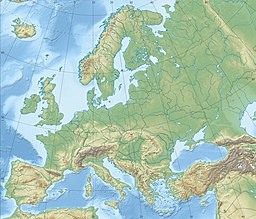geo.wikisort.org - Reservoir
Radoniq Lake or Radonjić Lake (Albanian: Liqeni i Radoniqit; Serbian: Радоњићко језеро / Radonjićko jezero) is a lake in Kosovo[a]. After only Gazivoda Lake, it is the second largest in the territory of Kosovo,[1][2] at 5.62 km2.
| Radoniq/Radonjić Lake | |
|---|---|
 Radoniq/Radonjić Lake and the Accursed Mountains in the background | |
| Location | Republic of Kosovo |
| Coordinates | 42°29′15″N 20°25′05″E |
| Primary outflows | Bistrica |
| Max. length | 4.7 km (2.9 mi) |
| Max. width | 2.2 km (1.4 mi) |
| Surface area | 5.06 km2 (1.95 sq mi) |
| Average depth | 15 m (49 ft) |
| Max. depth | 30 m (98 ft) |
| Residence time | 30 years |
| Surface elevation | 455 m (1,493 ft) |
| Islands | 0 |
 | |
In 1998, the lake was the site of the Lake Radonjić massacre.
Back in the 80‘s, there used to be a town under this lake. However during the process of making this artificial lake, the town had to be sunk under it. The residents had, of course, moved from the town once this happened. During different times of the year, once the tide is low, the very top of a church can be seen, as it remains still intact. It is a widely known fact to the people around the lake. However not many visitors know the whole story of this lake.
Notes
| a. | ^ The political status of Kosovo is disputed. Having unilaterally declared independence from Serbia in 2008, Kosovo is formally recognised as an independent state by 97 UN member states (with another 15 states recognising it at some point but then withdrawing their recognition), while Serbia continues to claim it as part of its own sovereign territory. |
References
- Pars pro toto
- The political status of Kosovo is disputed. Having unilaterally declared independence from Serbia in 2008, Kosovo is formally recognised as an independent state by 97 UN member states (with another 15 states recognising it at some point but then withdrawing their recognition), while Serbia continues to claim it as part of its own sovereign territory.
| Wikimedia Commons has media related to Lake Radonjićko. |
На других языках
[de] Radoniq-See
Der Radoniq-See oder auch Radonjić-See (albanisch Liqeni i Radoniqit, serbisch Радоњићко језеро .mw-parser-output .Latn{font-family:"Akzidenz Grotesk","Arial","Avant Garde Gothic","Calibri","Futura","Geneva","Gill Sans","Helvetica","Lucida Grande","Lucida Sans Unicode","Lucida Grande","Stone Sans","Tahoma","Trebuchet","Univers","Verdana"}Radonjićko jezero) ist ein Stausee im Westen des Kosovo, ca. elf Kilometer von der Stadt Gjakova entfernt. Der See wurde im März 1983 erstmals gestaut. Seinen Namen erhielt er vom Dorf, das durch die Entstehung des Stausees überflutet wurde.- [en] Radoniq lake
[ru] Радонич (водохранилище)
Ра́донич — водохранилище в Косове. Находится к северу от Джяковицы. Сооружено на притоке Белого Дрина, реке Пруэ. В Республике Косово является вторым по площади после водохранилища Газиводе. Площадь поверхности — 5,96 км². Объём воды — 0,113 км³.[источник не указан 760 дней]Другой контент может иметь иную лицензию. Перед использованием материалов сайта WikiSort.org внимательно изучите правила лицензирования конкретных элементов наполнения сайта.
WikiSort.org - проект по пересортировке и дополнению контента Википедии

